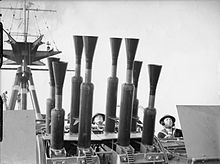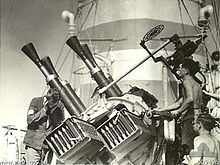QF 2 pounder naval gun

The QF 2-pounder ( Q uick F iring) was a light 40 mm anti-aircraft gun used by the British Navy . It was introduced in 1929 as an eight -fold mount (from 1935 also four-fold, later also in a stand-alone configuration ) and was used in the British Navy throughout the Second World War and thereafter. Because of the typical, staggered firing sequence of the individual tubes, the gun was also called "Pom-Pom" by the soldiers.
history

The origins of the gun go back to the time of the First World War.
Experiments had shown how dangerous aircraft could be to ships, and the aircraft carrier was becoming increasingly important as a modern weaponry. It was therefore imperative to strengthen the ships' anti-aircraft armament. While the defense of high-flying bombers , the 102-mm artillery was provided in connection with the HACS fire control system, to ward off torpedo bombers were multitubular machine guns provided. For this purpose, an eight-barrel mount was to be developed on the basis of the 2-pounder Mark II gun from Vickers from the First World War . The aim was to use the large quantities of two-pound ammunition available. The forerunner of this gun was in turn developed in the 1890s Maxim - Nordenfelt -1-pounder rapid-fire gun (37-mm- "Pom-Pom"), the plans of which were acquired by Vickers in 1897.
Vickers and Armstrong-Whitworth started development in the early 1920s. Vickers was able to beat the competitor out of the field and in 1923 presented a dummy of the gun. Due to a lack of funding, the first tests were delayed until 1927 (in the same year Vickers merged with Armstrong-Whitworth), and it was not until the end of 1930 that the first mass-produced gun could be installed on the HMS Valiant . Gradually, the gun was introduced on all battleships , battlecruisers and heavy cruisers . Later a quadruple mount was introduced for light cruisers and destroyers for which the eight was too heavy.
Several established in the broad side of the ship guns were capable of against attacking aircraft due to high cadence to put a real fire curtain in front of the ship. The pom-pom guns were the basis for the weapons used today for close-range defense, such as the CIWS phalanx .
technology
The gun was mounted eight or four times. The use of loading frames was innovative at the time of development. This Bofors invention was adopted by Elswick Ordnance Company (part of the former Armstrong Whitworth group). Eight linked belts with 14 cartridges each were housed in a frame. This ensured a rate of fire of about 115 rounds / min per barrel with a continuous supply of ammunition - also thanks to the water cooling of the barrels. Basically, the gun was designed so that the directional range was 360 °. However, since the superstructures of ships restricted the directional area, the base plate was designed in such a way that it could limit this area.
Due to the relatively short caliber length (L / 39), a muzzle velocity of only 585 m / s was achieved. This was accompanied by a maximum range of around 3500 m. This problem was to be resolved in 1938 by the introduction of a new version for cartridges with a larger propellant charge, with which the muzzle velocity was increased to 700 m / s. But it still lagged behind that of the 40 mm Bofors L / 60 (810 m / s) gun that the Royal Navy introduced in 1941. The weapon remained in production throughout the war, as the Bofors guns could not be produced in sufficient numbers. The lack of tracer bullets , which were only available from 1942, was initially problematic .
commitment
Each barrel of the eight-barreled gun was loaded separately. The gun crew consisted of a total of eight men, including a gun leader and a height and directional gunner. The gun barrels did not fire simultaneously, but staggered. A gunner team operated all eight tubes. It was responsible for targeting and serving. Later, the guns could be roughly set up using radar equipment on board the respective ship. The fine adjustment was again made by the gunner. The guns were fired by operating a crank ( controlled , variable rate of fire) or by pressing a button with the help of an electric motor.
Technical specifications
- Caliber: 40 mm
- Elevation range: −5 ° / + 90 °
- Muzzle velocity: 700 m / s
- effective shot height: 1525 m
literature
- Ian Hogg : 20th Century Artillery. Gondromverlag, Bindlach 2001, ISBN 3-8112-1878-6 .
- Gino Galupini: Encyclopedia of Warships. History, technology, data. Weltbild Verlag, Augsburg 1995, ISBN 3-89350-828-7 .
Web links
- 2 pounder Mark VIII on navweaps.com
- The Gunnery Pocket Book , manual for gun crews from 1945

